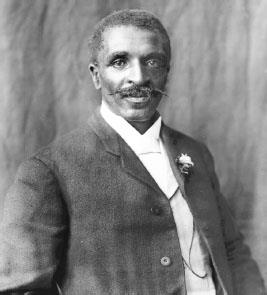Science, Inventions, Medicine, and AerospaceScience |
What were George Washington Carver’s agricultural discoveries? |
American botanist and agricultural chemist George Washington Carver (c. 1864–1943) won international fame for his research, which included deriving some four hundred products from peanuts, sweet potatoes, and pecans. He also created face powder, butter, cheese, milk, creosote, soaps, and stains. By 1924 he had become firmly established as the “Peanut Man,” and peanut growers and processors called on him for his expertise. The son of slave parents, Carver was born near Diamond Grove, Missouri, and through his own efforts obtained an education, earning a bachelor’s degree in 1894, and his master of science in agriculture, in 1896, from Iowa State University. That year he joined the faculty of Alabama’s Tuskegee Institute (now University) as director of agricultural research, remaining in this position until his death in 1943. His first research projects centered on soil conservation, crop diversification, and other agricultural practices. Carver gave lectures and made demonstrations to Southern farmers, particularly black farmers, to help them increase crop production. He followed the mission of Booker T. Washington, the school’s president, of taking education to the people. He took his mule-drawn “movable school” on weekend visits to impoverished farmlands to teach poor farmers to raise, improve, and preserve foods. Then he turned his attention to finding new uses for two Southern staple crops: peanuts and sweet potatoes. Carver found that peanuts could be used to make a milk substitute, printer’s ink, and soap. He found new uses for soybeans and devised products that could be made from cotton waste. His efforts were all intended to improve the economy in the American South and enhance the way of life of Southern black farmers. His scientific work improved the quality of life for millions of people. Carver was a cultural man as well—he was an accomplished pianist and a skilled painter.
Carver was lauded for his accomplishments: He was named a fellow of the Royal Society of Arts of London (1916); he was awarded the Spingarn Medal for distinguished service in agricultural chemistry (1923); and he was bestowed with the Theodore Roosevelt Medal for his valuable contributions to science (1939). He became the first black scientist memorialized by a federal monument in the United States. On July 14, 1953, the United States Congress authorized the establishment of the George Washington Carver National Monument; it was erected on his birth site and dedicated on July 17, 1960. In 1948 his photograph appeared on a commemorative stamp. His laboratory is the Carver Museum, a historic site on the campus of Tuskegee University.

Brilliant botanist and chemist George Washington Carver found hundreds of uses for peanuts, soybeans, pecans, and sweet potatoes. He received many honors, including being the first black man memorialized by a federal monument.
